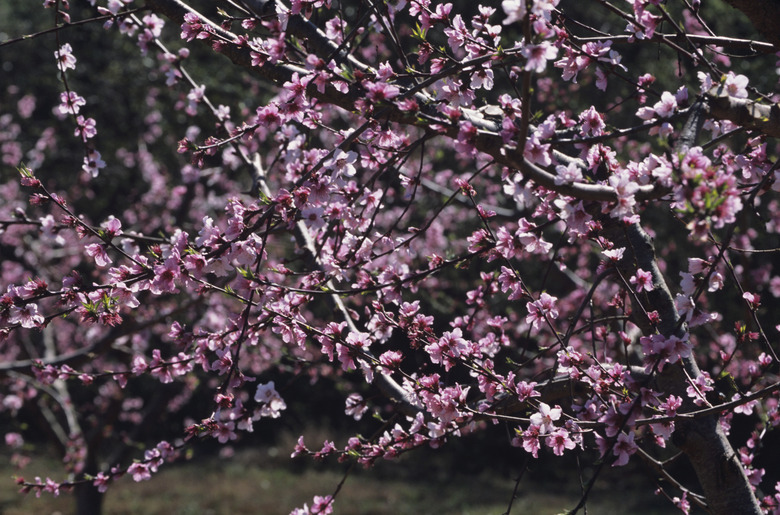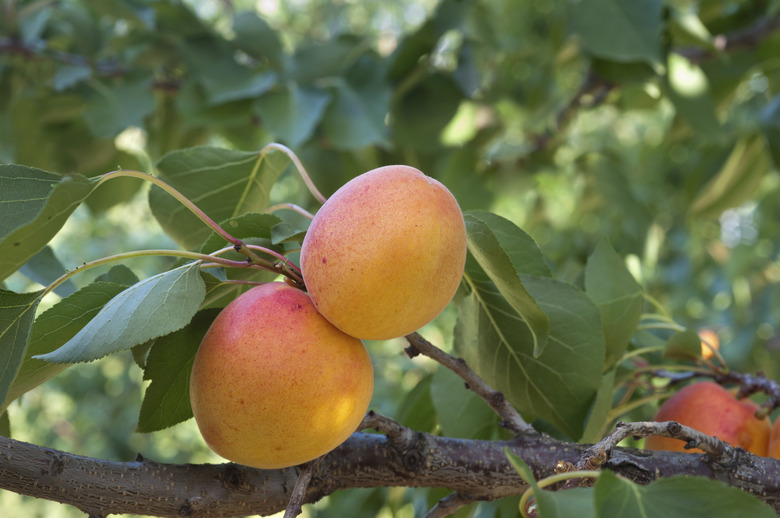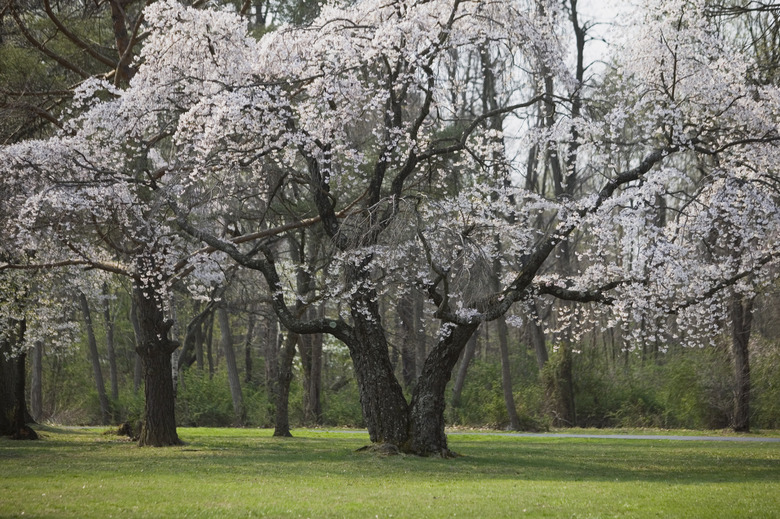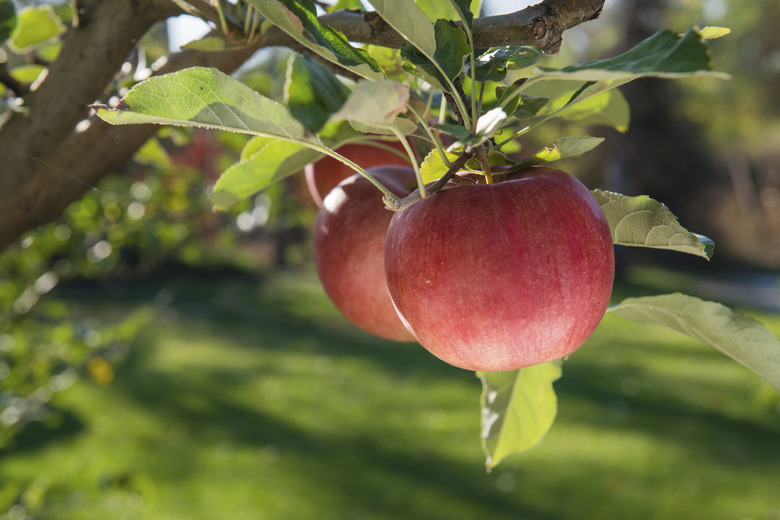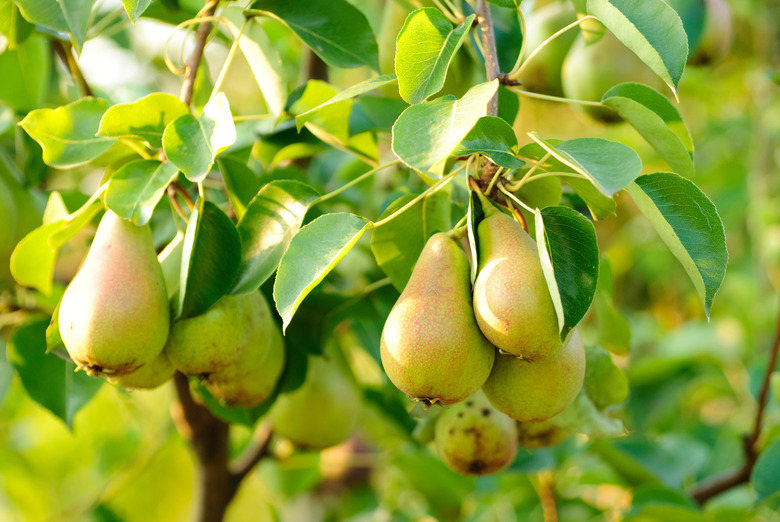List Of Deciduous Fruit Trees
Leaves perform several tasks for trees. They harness energy from the sun to produce food, and they take in carbon dioxide and release oxygen. Some even sacrifice themselves to the ground in fall so that their former host can enter a state of dormancy and survive winter. As opposed to evergreens, trees that lose their leaves each year are referred to as deciduous. Most people think of hardwoods when it comes to deciduous trees, but the group includes several fruit trees as well.
The Big Chill
Certain fruit trees literally need to "chill out" for a period of time each winter to become fruitful the following spring. Just how long they need to remain dormant varies with the species, cultivar and climate. Known as the "chilling requirement," this period of dormancy is measured in "chilling hours" and can range from a few hundred to a few thousand hours.
Stone Fruit Trees
Peach Tree
The common peach tree (Prunus persica) is native to China and hardy in U.S. Department of Agriculture plant hardiness zones 5 through 9. Although the tree tolerates any type of soil with adequate drainage, it does best in moist, acidic soil with a pH level of 7.0 or less. It grows best in a site with full sun — at least six hours of direct sun exposure each day — or partial shade. This tree does not, however, survive in full shade.
With a potential height and equal canopy spread of 15 to 25 feet, the peach tree can be grown as a living fence for privacy. Because it is deciduous, however, this strategy is feasible for only six months of the year. Still, the best reward for growing the tree is its cream-colored flowers that appear in spring and develop into juicy fruits in July and August.
- The common peach tree (Prunus persica) is native to China and hardy in U.S. Department of Agriculture plant hardiness zones 5 through 9.
- Although the tree tolerates any type of soil with adequate drainage, it does best in moist, acidic soil with a pH level of 7.0 or less.
Apricot Tree
The apricot tree (Prunus armeniaca) is native to East Asia and hardy in USDA zones 5 through 7. Growing about 29 feet tall and 19 feet in canopy width, the apricot produces small, bowl-shaped, white flowers in early spring and fleshy, orange-pinkish fruits from midsummer through fall. This tree isn't fussy about sunlight and does fine in full sun or partial shade. It needs moist but well-drained soil, however. Soil of any pH level is acceptable, but the tree grows best in sandy or loamy soil.
Sweet Cherry Tree
Also called wild cherry, sweet cherry (Prunus avium) is a deciduous tree hardy in USDA zones 3 through 7 but is original to Europe, West Asia and North Africa. Clusters of delicate, white flowers that emerge in early spring are a much celebrated feature of this species. In fact, several U.S. cities mark the arrival of spring with annual cherry blossom festivals, most notably the National Cherry Blossom Festival in Washington, D.C.
- The apricot tree (Prunus armeniaca) is native to East Asia and hardy in USDA zones 5 through 7.
- Growing about 29 feet tall and 19 feet in canopy width, the apricot produces small, bowl-shaped, white flowers in early spring and fleshy, orange-pinkish fruits from midsummer through fall.
Sweet cherry is a fast-growing tree that is capable of reaching almost 60 feet in height and a spread of more than 20 feet. Six hours or fewer of direct sun exposure per day is sufficient for the tree, and it tolerates any soil with adequate drainage. The sweet cherry's deep-red fruits appear in clusters on spur shoots in early to middle summer.
Stone fruit trees are so-called because each of their fruits harbors a large, hard, stonelike seed or pit. Technically, the fruits are drupes, which means each has a fleshy outer layer that surrounds a hard shell that holds a seed. Assigned to the Prunus genus, stone fruit trees are members of the Rose family (Rosaceae spp.).
- Sweet cherry is a fast-growing tree that is capable of reaching almost 60 feet in height and a spread of more than 20 feet.
- Stone fruit trees are so-called because each of their fruits harbors a large, hard, stonelike seed or pit.
Warning
The seeds of stone fruit trees contain hydrogen cyanide, an organic compound also known as prussic acid that disrupts the use of oxygen in every organ in the body, producing a system-wide toxic effect on the heart, lungs and central nervous system. Although it would be difficult to consume enough accidentally to be fatal, do not let children or pets gnaw on the fruit pits. Also, avoid eating fruit flesh that has a pronounced bitter almond flavor or aroma.
Tip
Stone fruit trees produce fleshy fruits that are eaten as-is, used to make filling for pies and other baked goods as well as used in ice cream and sorbet. The fruits also are used to make syrups and jams.
Pome Fruit Trees
Apple Tree
The cultivated apple tree (Malus domestica) may have evolved as a hybrid of various wild species native to Central Asia. Its fruit that, according to lore, "keeps the doctor away" is unlike most fruit in that it is borne of the floral cuplike tube that houses the flower sepals, stamens and calyx rather than the ovary.
The cultivated apple tree is hardy in USDA zones 3 through 8. Although it grows in any soil, it does best in organically rich, well-drained, loamy soil. The apple tree is typically grown in hedgerows in home orchards. Because it tolerates partial shade or dappled shade created by the canopies of neighboring trees, however, it is sometimes established in woodland settings.
Tip
Although apple tree's fruits are harvested to make pies, pastries, apple butter and cider, the tree's small, white flowers are appreciated for attracting butterflies and other pollinators.
Pear Tree
The common or European pear (Pyrus communis), also referred to as the wild pear, is a European, deciduous tree hardy in USDA zones 4 through 9. It tolerates all soil types and withstands drought and air pollution. It also grows in locations that receive just few hours of direct sun per day, but too much shade causes the tree to produce fewer fruits than normal. In addition to being valued for its tart fruits, the pear tree is sometimes strategically planted in rows or shelterbelts to protect crops and livestock from wind.
- The cultivated apple tree (Malus domestica) may have evolved as a hybrid of various wild species native to Central Asia.
- The common or European pear (Pyrus communis), also referred to as the wild pear, is a European, deciduous tree hardy in USDA zones 4 through 9.
- It tolerates all soil types and withstands drought and air pollution.
"Of all the deciduous fruit tree species, pears are the most tolerant of wet soil conditions. Yet they perform best on deep, well-drained sites."[](http://homeorchard.ucanr.edu/Fruits_&_Nuts/Pear/)
Tip
Pear tree's leaves yield a yellowish dye, and pear wood is used to make furniture and musical instruments.
Pome fruit trees, which are also in the Rose family, produce fruits that each has a core containing several small seeds. The term "pome" is derived from the Latin word "pomum," which translates to "apple."
References
- University of Florida, Gardening Solutions: Deciduous Fruit Trees
- University of Florida, Gardening Solutions: Chill Hours
- Plants for a Future: Prunus Persica
- University of Florida IFAS Extension: Prunus Persica
- Plants for a Future: Prunus Armeniaca
- U.S. Centers for Disease Control and Prevention: Hydrogen Cyanide
- Plants for a Future: Prunus Avium
- University of California: Pome Fruits
- Plants for a Future: Malus Domestica
- Plants for a Future: Pyrus Communis
